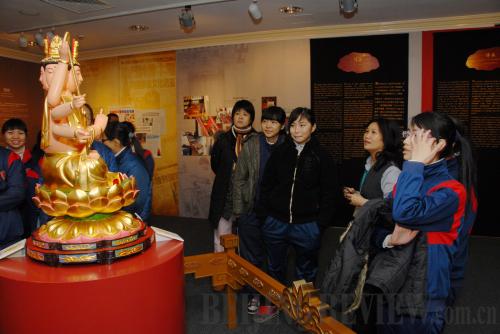|
 |
|
HOLY ART: An exhibition of religious sculptures, created using traditional woodcarving in Macao, was held at the Museum of Macao in January and attracted a large number of tourists (HE YUANCHENG) |
It has only been until recently that tourists have begun considering Macao a serious vacation destination; the region surpassed Las Vegas in 2006 to take the title of the gaming capital of the world. Now, local tourism and cultural authorities hope to tap Macao's other tourism resources and attract more visitors to tour the coastal region's heritage, which has been increasingly earning international recognition.
The Macao Special Administrative Region (SAR) Government hopes to further promote the former Portuguese colony as a place to explore the best blend of Eastern and Western cultures. Macao became an important international trade port in the mid-16th century and is the birthplace of China's first modern newspaper, Abelha da China. It is also home to China's earliest oil paintings.
The region's first United Nations Educational, Scientific and Cultural Organization (UNESCO) World Heritage Site is the Historic Center of Macao, a collection of 25 historic locations that includes urban squares, churches and temples. One location is Macao's most famous landmark, the ruins of St. Paul's Cathedral, which was Asia's largest in the 17th century. UNESCO recognized the area a living history book that displays the unique assimilation and co-existence of Chinese and Western cultures in 2005.
Museum of Macao Curator Chan Ieng Hin said that the region's residents, who have donated over half of the institutions' exhibits, generously support the protection and promotion of local culture. The museum, under the Cultural Affairs Office of Macao, is also in charge of Macao's application to be listed among the world's cultural heritage sites and intangible heritage.
The region of less than 30 square km, which has a population of some 549,000, has had three projects listed as national intangible cultural heritage since 2006—Cantonese Opera, Guangdong herbal tea and religious woodcarvings. The first two were jointly applied for by Macao, Hong Kong and Guangdong Province, whose cultures developed from the same origin and share many similarities. On September 30, 2009, UNESCO inscribed Cantonese Opera on the list of Intangible Cultural Heritage of Humanity.
Chan said the distinction of being listed as a cultural heritage site has helped rejuvenate traditional arts and crafts in Macao. Woodcarving of religious figures is a craft that developed out of the demands of workers on fishing boats, who sought to worship gods to be blessed for safe trips. The art was once on the verge of extinction due to the decline of the local fishing industry.
"Before carving religious figures became a part of our cultural heritage, few young people were willing to study the craft. Now the remaining two shops are booming, with orders coming from temples in the Chinese communities of many foreign countries. The shops are starting to recruit new apprentices," Chan said.
The number of visitors annually coming to Macao tripled from 1999 to 2008, with 22.9 million making a trip to the region last year.
"The Historic Center of Macao's inscription as a UNESCO world heritage site has greatly boosted tourism in Macao," said Joao Manuel Costa Antunes, Director of the Macao SAR Government Tourism Office. To promote the heritage site, the tourism office named 2006 as Macao World Heritage Year and launched promotional campaigns for the area's cultural legacy on the Chinese mainland and in Hong Kong and Taiwan, as well as Japan, Australia, Europe and North America.
Over half of tourists coming to Macao are from the Chinese mainland, so the tourism office has been cooperating with its mainland counterparts. Following an initiative to set up an office to jointly promote tourism in the Pearl River Delta in 1993, Hong Kong, Macao and the mainland's Guangdong have been upgrading a tourism information platform that provides comprehensive information covering the region. In June 2008, tourism agency associations from Macao and Guangdong's Jiangmen signed a contract to promote the two areas as destinations with world cultural heritage sites. Diaolou, the multi-storied defensive village houses in Kaiping, Jiangmen, was also named a world cultural heritage site in 2007.
"We have created four cultural brands in the last 10 years—the Macao International Music Festival, the Macao Arts Festival, the Macao Chinese Orchestra and the Macao Orchestra," said Ho Lai Chun, President of the Cultural Affairs Office of Macao SAR Government. According to the 2009 Macao International Music Festival's website, 98 percent of concert tickets for the one-month event in October were sold out and its outdoor concert alone attracted 8,000 people. | 